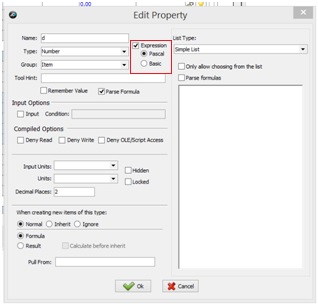To open any link in a new tab, preserving your position in the current article, just hold down the <CTRL> key on your keyboard before clicking the link or click using your mouse wheel.
How To: Establish a Property as a Pascal Expression (Difficulty Level: Basic)
Introduction
Before being able to create an if/then formula, a property must be established as a Pascal expression. This article will outline that process.
Basic Explanation of the Return Value Expression in PlanSwift
- In the formula column entering in [Property] brings the return the value of that property.
- In the formula column entering in '[Property]': by including the ' ' the return value of that property will be recognized as a text or string.
The image below shows an error because [a] is a number, [d] is a number but '[a]' returns as a text/string value which conflicts with the property d (which is a number type)
To fix the error above: simply change from '[a]' to [a] instead
Establishing a Property as a Pascal Expression
- In the properties window of any PlanSwift item, hit Advanced to pull up the Advanced Properties window.
- Right-click on a property you want to establish as an expression, then choose properties to bring up the Edit Property window.
- Check the box labeled Expression, then select Pascal.
- While in Edit Property, you can also edit the Name, Type, and Group if needed.
Caution: After editing a specific property to be a Pascal expression, other properties can no longer be dragged/dropped into that specific property. In order to accomplish the inheritance of another property into the now established Pascal expression property Result:= must be entered in.
Inherit Result from Other Property Cells Using a Pascal Expression (1)
- In the Formula cell, type in Result:=
- Any calculations between different properties can happen after Result:= is entered in.
(A normal drag-drop of other properties into the cell after the Result:= will now inherit value.)
Inherit Result from Other Property Cells Using a Pascal Expression (2)
- When a property is set to use Pascal Expression, the type of that property no longer matters--whether it is a text or a number; however, the return value expression needs to match with the type of the property it inherits the value from.
Example: b is a text type property. d is a Pascal expression with a text type property. An error is the result. The reason is that there is not single quotation marks entered around the result [b].
Example: b is a text type property. d is a number type but is set as a Pascal expression. By having '[b]' entered into the formula, the value now displays because quotation marks signify that the property is a text.
Example: a is a number 10 . b is a text . c is a Pascal expression property. d is a Pascal expressionproperty result:='[a]' return value 10 as a text (Number can return value as a text) result:=[b]return value b as a number. Text cannot return value as a number and will give an error result. Numbers can return as a text or number type, but text cannot return as a number, only as text type.
Copyright 2023 ConstructConnect





